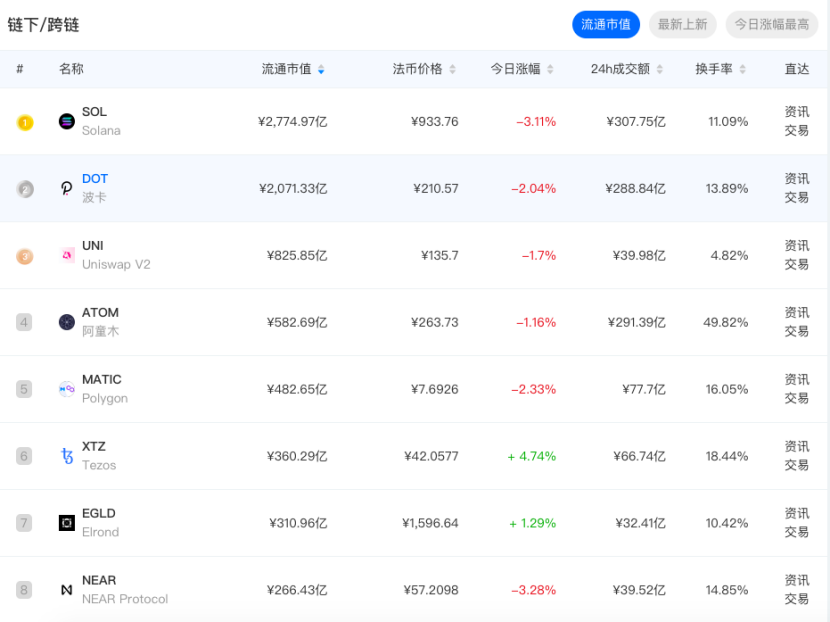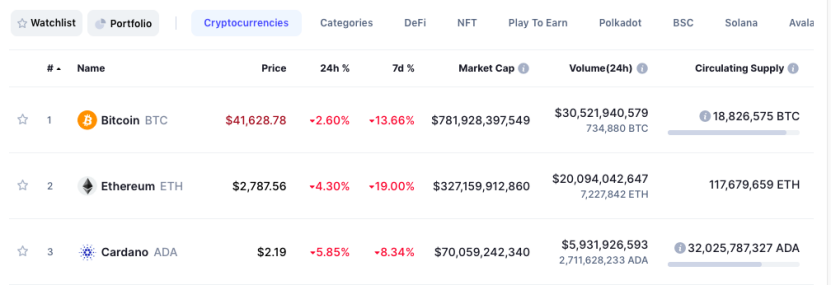first level title
More than 100 public chain projects, universal and cross-chain are new trends
first level title

What is the difference between Solana and the public chain boom?
secondary title
From the technical structure:
Solana: PoH Clock Solution
Different from most sharding + ETH2.0 schemes, Solana has created a unique and innovative PoH clock mechanism in the public chain circle. This scheme decouples the block generation time and state, and is not limited by the global consensus The hard requirements of block size and block generation time, through the global clock to generate a globally available time chain for all nodes, status updates can be performed in an asynchronous manner, verifiers can send status updates to other nodes in real time, and the PoH clock gives Solana ecological participation Or a larger expandable space, which further improves and expands the overall throughput capacity.
Near: Fragmented Network
Near, known as Ethereum 2.0, is a shardable and expandable blockchain, which will further break through the performance limit of smart contracts as a collaborator of Ethereum. Bridge back to Ethereum by building a brand new and compatible Lay1 public chain. Specifically, it is to divide a transaction block into several smaller sub-blocks, each node only verifies a part of the transactions of the shard, and no longer needs to participate in all transaction verification, according to the method of dispersing the amount of tasks and synchronous calculation , which reduces the verification pressure and increases the transaction speed, and this sharding protocol is named Nightshade (Night Shadow Protocol) by Near. According to reports, the transaction speed of Near is 1,000 times that of Ethereum 1.0, and it is now online. The latest news is that Near will release a simplified version of the Yeying protocol in November and enter the 0th stage of sharding.
Cardano: Layered Blockchain Ecosystem
The halo of Charles Hoskinson, the former co-founder of Ethereum, made the arrival of Cardano a highlight. The project proposed the concept of "layered blockchain ecology", which divides the entire framework into a settlement layer and a computing layer, and solves currency and intelligence in a targeted manner. There are two levels of contract issues. This design is more compatible with regulatory requirements and has greater opportunities to cooperate with large companies or governments in the future. According to online news, Taurus, a Swiss compliant digital asset organization, has integrated the Cardano chain, and its officials revealed that it has established relationships with several large partners.
Avalanche: triple chain structure
In the last month, the Avalanche avalanche protocol entered the public eye by means of incentives, achieving a sharp increase in currency prices and locked positions. Also as a smart contract platform, Avalanche is very innovative in architecture design, adopting a three-chain structure of X chain, C chain, and P chain. The X chain is a transaction chain, which mainly handles point-to-point asset creation and transaction between individuals; the C chain is a smart contract chain compatible with EVM, and the basic DeFi projects are built on the C chain; the P chain is a platform chain, which is mainly responsible for representing Coin staking, coordinating network validators, creating custom subnets, and more. The three chains perform their own duties, but they complement each other, further liberating Avalanche's network performance.
Cosmos & Polkadot: Cross-chain dual kings
If Bitcoin is public chain 1.0 and Ethereum is public chain 2.0, then Cosmos and polkadot can be called public chain 3.0. Through the cross-chain architecture design, it aims to break the island situation of the previous public chain. The Cosmos technical framework is divided into central hub chain Hubs and regional chain Zones, while polkadot is divided into relay chains and parallel chains, and information transmission between chains is realized through the IBC protocol and the XCMP protocol respectively. Each sub-chain of this type of project can be compared to an Ethereum single-chain. Projects on the chain can interoperate with other sub-chains to create an interoperable value ecology according to their own business needs. At present, this type of cross-chain is more about bridging and mapping existing resource assets such as Ethereum and Bitcoin to its own ecology, and simultaneously cultivating and supporting its own ecological projects. Due to the high difficulty of implementing cross-chain public chain technology, it also requires more development time.
secondary title
Ecological support:
Capital is always profit-seeking, which is more obvious in the encrypted world. From the perspective of the development of the public chain, if you want to engage in ecology, you must be willing to invest. Last month, after Avanlanche released a $180 million incentive plan, it immediately started an ecological skyrocketing trend, and the rapid rising market was staged as early as Polygon. It can be said that launching an incentive or support plan has become the only rule for public chains to capture user traffic.
secondary title
Ecological richness:
image description

secondary title
Looking at future development:
According to the data from mytoken, there are 88 off-chain & cross-chain projects. Of course, this also includes some cross-chain agreements. In terms of market value circulation, Solana’s token SOL has the highest market value at 227.4 billion, followed by DOT and ATOM Wait, the top ten lists are all relatively well-known cross-chain projects. Judging from the circulation market capitalization of Coinmarketcap, new public chains such as Cardano, Solana, Polkadot, Avalanche, and Cosmos are among the top 20 on the list, and Cardano even ranks third on the list. This is also related to the good news that Cardano recently released the main network deployment Alonzo hard fork upgrade and enabled smart contract functions. The project party revealed that hundreds of projects are expected to be deployed in September and October, and the deployment will be accelerated in the fourth quarter. It also means that Cardano's project ecological development is about to set sail.


In addition to Cardano, Near, which is currently closely related to the Ethereum Foundation, is also worthy of attention. It has attracted many institutions and communities including D1 and IOSG to make immersive investments in it. Currently, Near ranks 43 on the market value list. With the launch of the Yeying protocol, Near's sharding will gradually enter the stage of infinite expansion of dynamic re-sharding, and there is still a lot of room for improvement in this process. There is also Polkadot. At present, the Kusama parachain slot on the test network has opened its ninth auction. Although the Kusama network is running stably, the enthusiasm for pledge auctions in the market is not as high as expected. The future development depends on Polkadot Slot auction and the degree of interactivity of each project party.